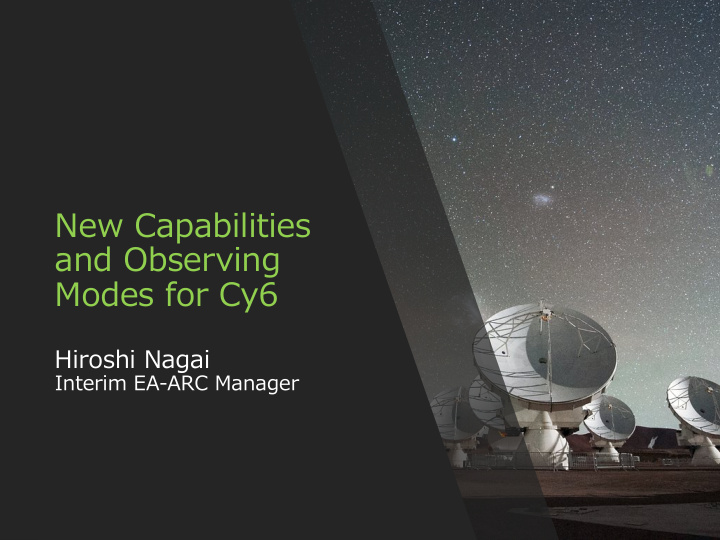



� New Capabilities and Observing Modes for Cy6� Hiroshi Nagai � Interim EA-ARC Manager �
What’s new in Cy6? � • Circular polariza7on will be accepted for Bands 3, 4, 5, 6, and 7. The minimum detectable degree of circular polariza7on, defined as three 7mes the systema7c calibra7on uncertainty, is currently 1.8% of the peak flux for both TDM and FDM observa7ons. • Band 8 standard mode • Band 8 ACA Standalone • Band 6 IF extension: The Band 6 IF bandwidth has been increased by 0.5 GHz to extend from 4.5 to 10 GHz. �
General Informa7on � • ALMA Cycle 6 will start in early October 2018 and span 12 months. It is an7cipated that 4000 hours of 12-m Array 7me will be available for successful observa7ons of approved projects, and 3000 hours will be available on the Atacama Compact Array (ACA), also known as the Morita Array. � 18 December 2017 Cycle 6 pre-announcement 1 February 2018 Addi7onal informa7on on configura7on schedule Release of the ALMA Cycle 6 Call for Proposals and Observing 20 March 2018 Tool, and opening of archive for proposal submission 19 April 2018 Proposal deadline 18-23 June 2018 Proposal Review mee7ng End of July 2018 Result of the proposal review sent to Proposers 6 September 2018 Deadline for Phase 2 submission by Proposers October 2018 Start of ALMA Cycle 6 observa7ons September 2019 End of Cycle 6 observa7ons
Proposal Types � • Same as in Cy5 • Regular Proposals may request up to 50 hours of 12-m Array 7me or up to 150 hours of ACA stand-alone 7me. • Large Programs may request more than 50 hours of 12- m Array 7me or more than 150 hours of ACA stand- alone 7me. Up to 600 hours of 12-m Array 7me and 450 hours of ACA stand-alone 7me will be allocated to Large Programs. • Proposals will be accepted for Very Long Baseline Interferometry (VLBI) observa7ons with ALMA in Bands 3 and 6 (wavelengths 3 mm and 1.3 mm) in the con7nuum only. �
An7cipated Capabili7es � • ≧ forty-three antennas in the 12-m Array • ≧ ten 7-m antennas and three 12-m antennas in the ACA • Receiver bands 3, 4, 5, 6, 7, 8, 9 and 10 (wavelengths of about 3.1, 2.1, 1.6, 1.3, 0.87, 0.74, 0.44 and 0.35 mm, respec7vely) • Spectral line, con7nuum, and mosaic observa7ons ‒ Spectral line and con7nuum observa7ons with the 12-m Array and the 7-m Array in all bands ‒ Single field interferometry (all bands) and mosaics (Bands 3 to 9) with the 12-m Array and the 7-m Array ‒ Single dish spectral line observa7ons in Bands 3 to 8
An7cipated Capabili7es � • 12-m configura7on • Maximum baselines for the antenna configura7ons will vary from 0.15 km to 16 km • Maximum baselines of 3.6 km for Bands 8, 9 and 10 • Maximum baselines of 8.5 km for Band 7 • Maximum baselines of 16 km for Bands 3, 4, 5 and 6 • Antenna configura7on file for CASA simula7ons will be made available on the ALMA Science Portal by 1 February 2018 • Single poin7ng, on axis, linear and circular polariza7on for both con7nuum and full-spectral-resolu7on observa7ons in Band 3, 4, 5, 6, and 7 on the 12-m Array. The field of view of both linear and circular polariza7on observa7ons is limited to the inner 1/3 of the primary beam.
Standard / Non-standard modes � • Standard mode observa7ons will be calibrated with the ALMA Pipeline while non-standard by manual. • Up to 20% of the observing 7me will be allocated to non-standard. Ø Band 9 and 10 observa7ons (Band 8 is standard!) Ø Band 7 observa7ons with maximum baselines > 5 km Ø All polariza7on observa7ons Ø Spectral scans Ø Bandwidth switching projects (less than 0.9375 GHz aggregate bandwidths over all spectral windows) Ø Solar observa7ons (Bands 3 and 6) Ø VLBI observa7ons Ø User-specified calibra7ons Ø Astrometry �
Recommend
More recommend